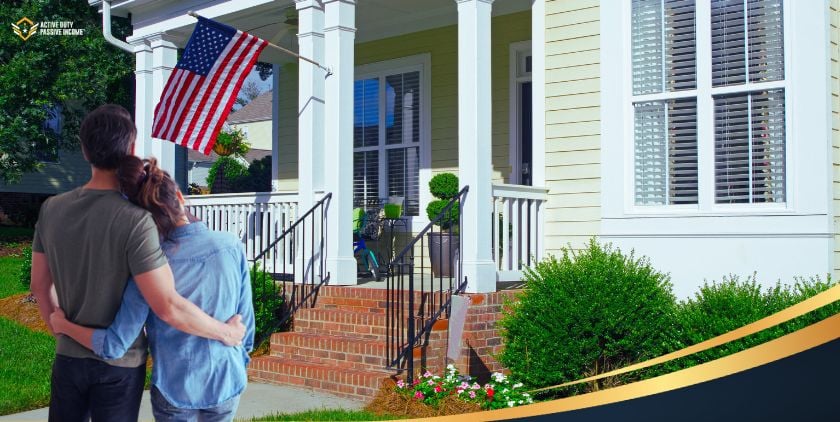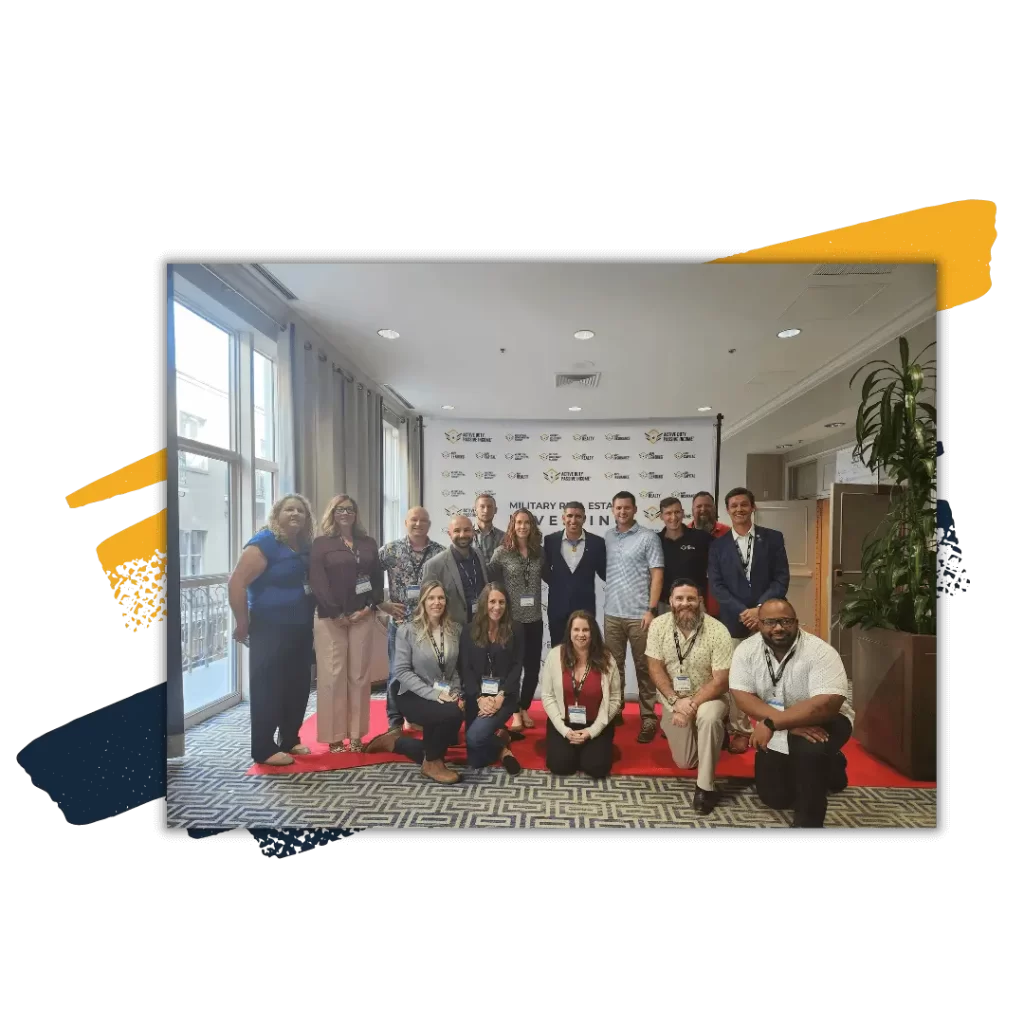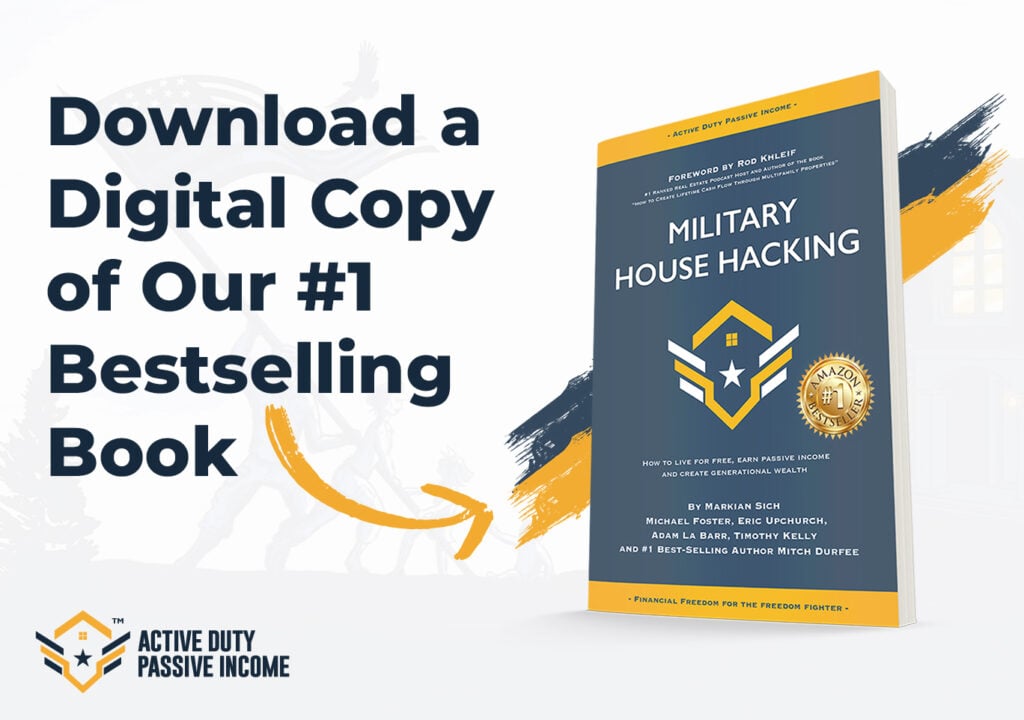VA loans come with occupancy requirements that borrowers must live in the property to obtain financing and keep their loan. VA loans are a fantastic way to buy a home let’s dig into and explain everything you need to know about VA loan occupancy requirements, including the occupancy requirements, and what possibly happens if you don’t meet them. Now before we get started let me remind you or clarify for you that if you buy a 2, 3 or even a 4 door property there is not an expectation that you will live in all 4 living spaces. The VA very much understands that you would live in one of the property’s homes but you will actually be rewarded for the income you will generate from the others by renting them out! Many of the investors, coaches and team members here at Active Duty Passive Income started with their VA loans purchasing multi unit properties and have since then launched into huge, successful real estate investing careers!
Home Occupancy Rules for VA Loans
The Home Occupancy Rules for VA Loans are put in place to ensure that the borrower intends to use the property as their primary residence. Typically, home buyers who purchase a home with a VA loan are required to occupy the property as their primary residence within 60 days after closing. However, the VA does offer some flexibility for certain circumstances. In specific situations, home buyers may be able to extend their occupancy beyond the 60-day mark, up to a maximum of one year. Then live in the purchased property as their primary residence for at least 12 months. While the VA does not provide a specific guideline, this is a great rule of thumb and lenders will want to be a part of the discussion if your intention is anything outside of this norm.
Although these documents do establish a commitment to occupancy, they also allow for exceptions in certain situations. The VA loan is intended to help Veterans purchase a home for their own personal use and not as an investment property. However, there are some exceptions to this rule, such as when the borrower is deployed or faces hardship. In such cases, the borrower may be able to request a waiver of the occupancy requirement. If the borrower fails to meet the occupancy requirement without an approved waiver, the loan may be considered in default, and result in the loan being called due in full, and the borrower may be required to pay back the entire loan amount immediately.

Exceptions to the VA Loan Occupancy Requirements
While VA loan occupancy requirements mandate that borrowers must intend to occupy the property as their primary residence, there are some exceptions to this rule. These exceptions are designed to provide flexibility for Veterans who may face unique circumstances that prevent them from occupying the property immediately or for an extended period. For example, if a borrower is on active duty and deployed to a different location, they may be able to obtain a waiver of the occupancy requirement. Similarly, if a borrower experiences a hardship, such as a job loss or medical emergency, they may be able to request a waiver. The VA and lenders will also make accommodations if the borrower is a surviving spouse of a Veteran who passed away in the line of duty or from a service-related disability, they may be able to use the VA loan benefit without occupying the property. These exceptions provide valuable flexibility for Veterans and their families while still maintaining the integrity of the VA loan program.
Property Repairs or Improvements
An exception to the VA loan occupancy requirement is for property repairs or improvements. In some cases, the borrower may purchase a property that requires significant repairs or renovations before it can be occupied. In these instances, the borrower may be able to obtain a waiver of the occupancy requirement for up to 12 months while they complete the necessary repairs. This exception allows Veterans to purchase homes that may need repairs or improvements without being penalized for not immediately occupying the property. However, it’s important to note that the borrower must still intend to occupy the property as their primary residence once the repairs or renovations are complete. Additionally, the borrower must provide a detailed plan outlining the repairs or improvements and obtain approval from the lender before the waiver can be granted.
Very interesting fact is that many people do not know about the opportunity to take out a loan using their VA loan benefits to buy a fixer upper, check out our blog section on the parameters on how this can be done and all of the fun facts you need to know to get started!
Intermittent Occupancy for home loan
The Intermittent Occupancy exception is a type of waiver available for VA loans that allows borrowers to occupy the property for certain periods while they fulfill other obligations, such as employment or educational requirements. This exception is commonly used by Veterans who need to move frequently due to their military service or other government-related duties. Under this exception, the borrower must still intend to occupy the property as their primary residence, but they may be able to use the property intermittently while fulfilling their obligations elsewhere. To obtain the intermittent occupancy waiver for a VA loan, the borrower must provide a detailed explanation of their situation and obtain approval from both the lender and the VA. It’s important to note that this exception may be more difficult to obtain than other waivers, so borrowers should be prepared to provide ample documentation to support their request.
Unusual Circumstances
There is no specific “Unusual Circumstances” exception for VA loan occupancy requirements. However, the VA may consider granting a waiver on a case-by-case basis for borrowers who face unique circumstances that are not covered under the other exceptions. These waivers are typically granted when there is a compelling reason that the borrower is unable to occupy the property as their primary residence, such as a natural disaster or a sudden change in the borrower’s health. Borrowers who believe they may qualify for an unusual circumstances waiver should contact their lender or the VA directly to discuss their options.
Spouse and Occupancy for VA Loan
For VA loans, the occupancy requirement for a primary residence can also be met by a Veteran’s spouse in some cases. If the Veteran is unable to occupy the property due to their military service, their spouse may be able to meet the occupancy requirement on their behalf. Additionally, if the Veteran has passed away, their surviving spouse may be able to use the VA loan benefit without occupying the property. To qualify under these circumstances, the spouse must still intend to use the property as their primary residence and meet all other eligibility requirements for the VA loan program. It’s important to note that lenders may have additional requirements or restrictions for spouses seeking to meet the occupancy requirement, so borrowers should consult with their lender for specific details.
Dependent Child Occupancy for VA Loan
Dependent child occupancy is another way to satisfy the occupancy requirement. If a Veteran has dependent children who will be living with them in the home, the occupancy requirement may be met by the child’s occupancy on behalf of the Veteran. In this case, the child must be a dependent of the Veteran and have legal custody established. The child must also intend to use the property as their primary residence and meet any age and other eligibility requirements set by the VA loan program. It’s important to note that lenders may have additional requirements or restrictions for dependent child occupancy, so borrowers should consult with their lender for specific details. Additionally, the Veteran must still be able to financially support their dependents and meet all other eligibility requirements for the VA loan program.
Delayed Occupancy
There are many reasons a military member could use the Delayed Occupancy exception for a VA loan. For example, if a service member is currently deployed or on temporary duty, they may be able to delay their occupancy until they return to the area. Similarly, if a service member is scheduled for a permanent change of station (PCS), they may be able to delay their occupancy until they are able to relocate to the area. To qualify for the Delayed Occupancy exception in these situations, the borrower must still intend to occupy the property as their primary residence, and they must provide a detailed explanation of their situation and obtain approval from both the lender and the VA. This Delayed Occupancy waiver in many cases is very hard to get approved because the idea overall is for the VA loan to support the Veteran and their family in obtaining a home to live it. In some cases a well written narrative and supporting documentation can be placed into a wavier package but be prepared to have many conversations and proof of the situation beyond just saying “I want to live there someday” as this can be a very risky situation for lenders. Don’t be afraid to ask the questions, but do understand that the lender and the VA both need to ensure that the risk is not too far out of reach for you as the borrower to cover the payments and responsibilities.
Retirement Occupancy
Retirement occupancy is an exception that is designed to help borrowers who are nearing retirement and plan to move into a new primary residence after they retire. Under normal circumstances, borrowers are required to occupy the property within 60 days of closing on a VA loan. However, if a borrower can provide documentation showing that they will retire within 12 months of closing on the loan, they may be able to satisfy the occupancy requirement using retirement income.
To qualify for this exception, the borrower must provide the lender with documentation that shows they will be retiring within 12 months of closing on the loan. This documentation may include a retirement letter or other official documentation from their employer. In addition, the borrower must demonstrate that they have sufficient retirement income to meet the lender’s requirements for income qualification and occupancy. This may require the borrower to provide documentation of their retirement income, such as a statement from their retirement account. Also, something to be considerate about before signing that contract for your retirement home is to ensure that you have proof of how you will fund your retirement home and your current living expenses. Less than a year left before retirement can be tricky for lenders to accept rental agreements as a form of proof of income. It’s not impossible but it does add a layer of proof needed when you are applying and getting approved.

Rental Occupancy for VA Loan
Rental occupancy is not typically allowed for VA loans, as the primary purpose of a VA loan is to help military members and Veterans purchase and occupy their own homes. However, there are some limited circumstances where rental occupancy may be allowed as an exception to the VA loan occupancy requirement.
For example, a borrower may be able to rent out a portion of their property if it has separate living quarters that are not connected to the main living area of the home. In this case, the borrower must occupy the main living area of the home as their primary residence and rent out the separate living quarters.
Additionally, if a borrower is required to move away from their primary residence due to military orders or other qualifying reasons, they may be able to rent out their home for a period of time while they are away. This is known as the “Temporary Residence” exception, and it allows the borrower to maintain their VA loan eligibility while they are away from their home.
Does The VA Check Home Occupancy?
Yes, the VA does check home occupancy for VA loans. The VA loan program requires that the borrower occupy the home as their primary residence within 60 days of closing on the loan, and the VA may conduct spot checks to ensure that the borrower is complying with this requirement.
In addition, lenders are required to verify the borrower’s occupancy status at regular intervals during the first year of the loan, and they may be required to provide this information to the VA. The VA may also conduct periodic reviews of loans to ensure that borrowers are still occupying the home as their primary residence.
If the VA or the lender discovers that the borrower is not occupying the home as their primary residence, this could result in the loan being called due in full, and the borrower may be required to pay back the entire loan amount immediately. Additionally, the borrower’s VA loan eligibility could be affected if they are found to have misrepresented their occupancy status.
How Does the VA Certify House Occupancy?
The VA certifies house occupancy through a combination of requirements and verification procedures. When a borrower applies for a VA loan, they are required to certify that they intend to occupy the home as their primary residence within 60 days of closing on the loan. This certification is included in the borrower’s loan application.
Once the loan is closed, the lender is required to verify the borrower’s occupancy status at regular intervals during the first year of the loan. This verification may include checking utility bills, verifying that the borrower has a driver’s license or voter registration at the home’s address, or conducting an in-person inspection of the property.
The VA may also conduct spot checks to ensure that the borrower is occupying the home as their primary residence. If the VA or the lender discovers that the borrower is not occupying the home as their primary residence, this could result in the loan being called due in full, and the borrower may be required to pay back the entire loan amount immediately.
Overall, the VA certification of house occupancy is a serious requirement, and borrowers should be prepared to provide documentation and undergo verification procedures to ensure that they are meeting this requirement.
What is the “reasonable time period” rule in VA Loan Occupancy Requirements?
The “reasonable time period” rule in VA loan occupancy requirements refers to the amount of time a borrower has to occupy the property after closing on the loan. Specifically, the borrower is required to occupy the property as their primary residence within a “reasonable time” after closing on the loan.
The VA does not provide a specific time frame for what constitutes a “reasonable time,” as this can vary depending on the circumstances. However, the borrower is generally expected to occupy the property within 60 days of closing on the loan. If the borrower is unable to occupy the property within this time frame, they may be able to use one of the exceptions to the occupancy requirement, such as the intermittent occupancy exception or the rental occupancy exception.
It’s important to note that failing to occupy the property within a reasonable time after closing on the loan could result in the loan being called due in full, and the borrower may be required to pay back the entire loan amount. Borrowers should be prepared to occupy the property as their primary residence within a reasonable time after closing on the loan. There are many solutions to buying with the VA loan and getting approved to extend or communicate the primary residence requirements, therefore trying to be sneaky and risking your VA entitlement is truly not worth it, remember the VA is there to help Veterans obtain safe and affordable housing!
ADPI Pro Tips
Here are some pro tips related to VA Loan Occupancy Requirements:
- Be familiar with the VA occupancy rules before applying for a VA loan to avoid surprises and ensure that you can comply with the requirements.
- Communicate any changes in your employment or family circumstances that may impact your ability to occupy the property with your lender to avoid any issues with meeting the VA occupancy requirements.
- If you are planning to use the rental occupancy exception, make sure to work with your lender to understand the specific requirements and limitations of this exception.
This blog was written in collaboration with our absolutely amazing DoD SkillBridge employee: Joe










